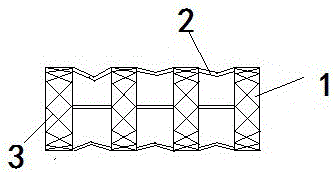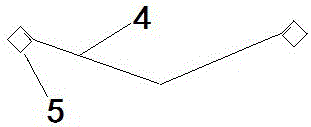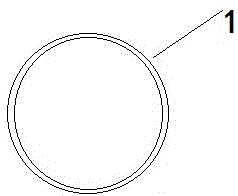Endovascular intervention stent
A vascular and annular body technology, applied in the field of endovascular interventional stents, can solve the problems of intimal hyperplasia and high vascular restenosis ratio, and achieve the effect of convenient separation
- Summary
- Abstract
- Description
- Claims
- Application Information
AI Technical Summary
Problems solved by technology
Method used
Image
Examples
Embodiment 1
[0026] An intravascular interventional stent, comprising a plurality of annular bodies and the plurality of connecting parts for connecting the annular bodies, the annular body has a plurality of cross tendon beams evenly distributed along the ring, and the connecting parts have a V shape Connecting rod, the end of the connecting rod has a square buckle for connecting the ring body, the connecting part and the ring body are covered with a coating,
[0027] The annular body is a titanium-based alloy material, and its element composition is (mass percentage): Cr 6%, Si 4%, Zn 6%, B 2%, V0.8%, Zr 0.8%, Bi 0.2%, Ag 0.3% , Mg0.1%, La 0.08%, Y 0.01%, Nb0.07%, the balance is Ti,
[0028] The connecting part is a copper-based alloy material, and its element composition is (mass percentage): Mg 16%, Ba 5%, Ni 3%, Nb1%, Ti 0.6%, Ca 0.4%, Ce 0.07%, Ag 0.07%, Fe0. 06%, Bi 0.02%, Co 0.03%; Pr 0.02%, the balance is Cu,
[0029] The coating includes: 100 parts of boron carbide, 60 parts of...
Embodiment 2
[0031] An intravascular interventional stent, comprising a plurality of annular bodies and the plurality of connecting parts for connecting the annular bodies, the annular body has a plurality of cross tendon beams evenly distributed along the ring, and the connecting parts have a V shape Connecting rod, the end of the connecting rod has a square buckle for connecting the ring body, the connecting part and the ring body are covered with a coating,
[0032] The annular body is a titanium-based alloy material, and its element composition is (mass percentage): Cr 7%, Si 5%, Zn 6%, B 1%, V0.8%, Zr 0.8%, Bi 0.3%, Ag 0.3% , Mg0.1%, La 0.09%, Y 0.01%, Nb0.07%, the balance is Ti,
[0033] The connecting part is a copper-based alloy material, and its element composition is (mass percentage): Mg 15%, Ba 6%, Ni 3%, Nb1%, Ti 0.6%, Ca 0.4%, Ce 0.08%, Ag 0.08%, Fe0. 05%, Bi 0.03%, Co 0.02%; Pr 0.02%, the balance is Cu,
[0034] The coating includes: 100 parts of boron carbide, 70 parts of...
Embodiment 3
[0036] An intravascular interventional stent, comprising a plurality of annular bodies and the plurality of connecting parts for connecting the annular bodies, the annular body has a plurality of cross tendon beams evenly distributed along the ring, and the connecting parts have a V shape Connecting rod, the end of the connecting rod has a square buckle for connecting the ring body, the connecting part and the ring body are covered with a coating,
[0037] The annular body is a titanium-based alloy material, and its element composition is (mass percentage): Cr 6.5%, Si 4.5%, Zn 5.5%, B1.5%, V 0.85%, Zr 0.75%, Bi 0.25%, Ag 0.25% , Mg0.15%, La 0.085%, Y 0.015%, Nb0.065%, the balance is Ti,
[0038]The connecting parts are copper-based alloy materials, and its element composition is (mass percentage): Mg 15.5%, Ba 5.5%, Ni2.5%, Nb 1.5%, Ti 0.65%, Ca 0.35%, Ce 0.075%, Ag 0.075%, Fe0.055%, Bi 0.025%, Co0.025%; Pr 0.025%, the balance is Cu,
[0039] The coating includes: 100 parts...
PUM
 Login to View More
Login to View More Abstract
Description
Claims
Application Information
 Login to View More
Login to View More - R&D
- Intellectual Property
- Life Sciences
- Materials
- Tech Scout
- Unparalleled Data Quality
- Higher Quality Content
- 60% Fewer Hallucinations
Browse by: Latest US Patents, China's latest patents, Technical Efficacy Thesaurus, Application Domain, Technology Topic, Popular Technical Reports.
© 2025 PatSnap. All rights reserved.Legal|Privacy policy|Modern Slavery Act Transparency Statement|Sitemap|About US| Contact US: help@patsnap.com



